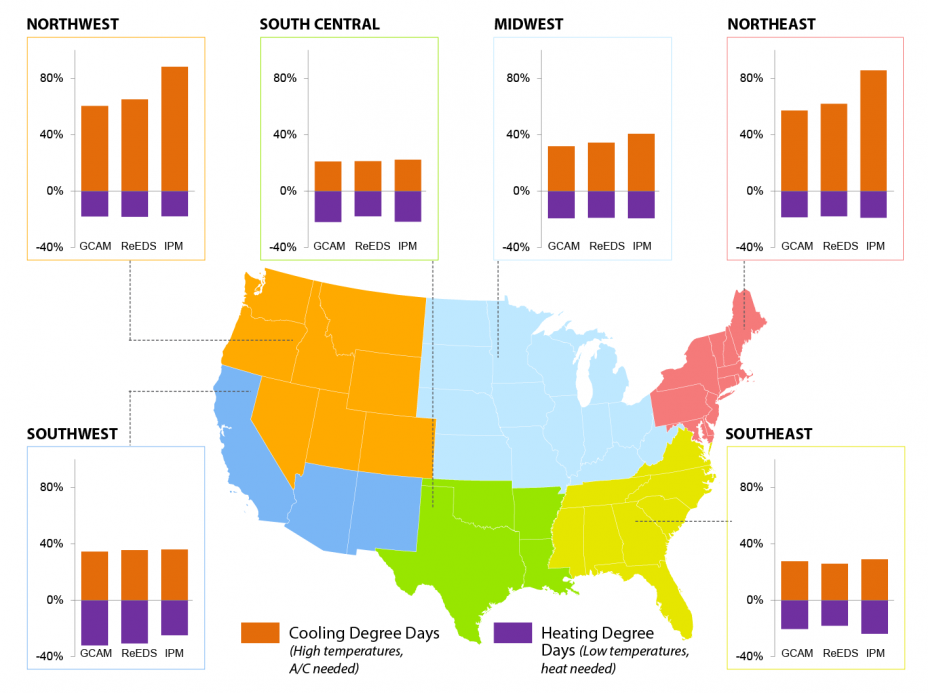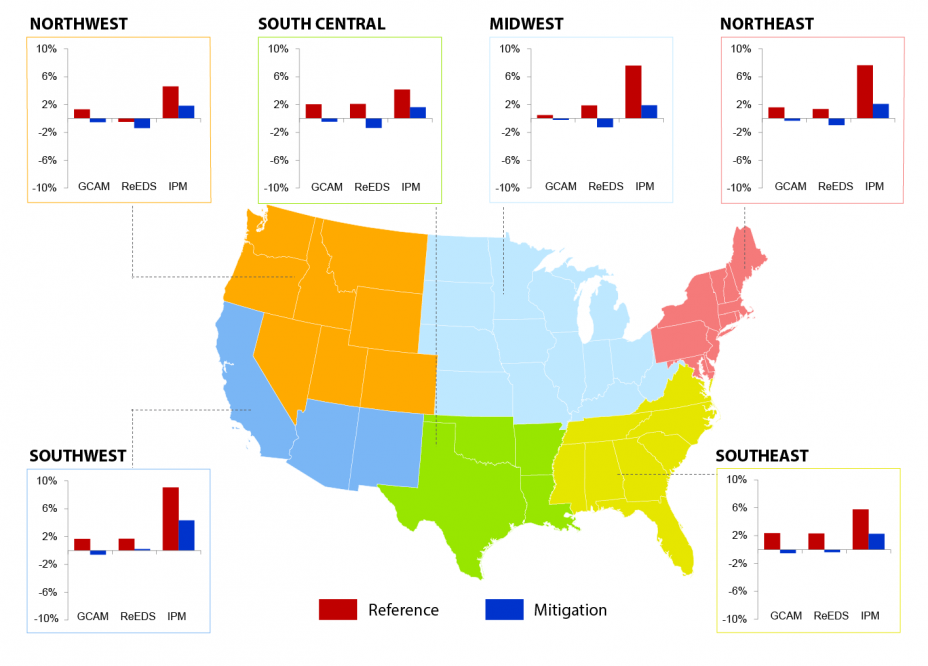Climate Action Benefits: Electricity Demand

As air temperatures rise due to climate change, electricity demands for cooling are expected to increase in every U.S. region.5 Higher summer temperatures, particularly during heat waves, will likely increase peak electricity demand, placing more stress on the electricity grid and increasing electricity costs. Although the majority of U.S. residential and commercial cooling demand is met with electricity, less than 9% of heating demand is met with electricity.6,7 Therefore, although higher average temperatures are expected to reduce electricity demands for heating, net electricity use is projected to increase under climate change. This section presents estimated impacts on electricity demand, but does not consider impacts on demand for other fuel sources used in residential cooling or heating.
On this page:
Additional information:
Key Findings
- Without global GHG mitigation, rising temperatures will likely result in higher electricity demand across the country, as the increased need for air conditioning outweighs decreases in electric heating requirements. The estimated percent increase in electricity demand for air conditioning is highest in the Northeast and Northwest regions.
- Global GHG mitigation, which lessens the rise in temperature, is projected to lead to lower electricity demand across all regions of the country relative to the Reference scenario.
Risks of Inaction
Rising temperatures are projected to increase electricity demands for cooling. Figure 1 shows the percent change in regional heating and cooling degree days (HDDs/CDDs, see Approach for definitions) from 2005 to 2050 in the Reference scenario. Results are presented for the three models used in the analysis (GCAM, ReEDS, and IPM), which exhibit similar trends of falling HDDs (shown in purple) and rising CDDs (shown in orange). These trends are consistent with projections described in the assessment literature.8 Across the U.S., HDDs decrease between 18%-29% on average, with greater decreases occurring in the South due in part to already-high temperatures. The increase in CDDs is highest in the Northeast and Northwest (68% and 71% on average, respectively). The projected changes in HDDs and CDDs have implications for regional electricity demand. Average U.S. electricity demand is projected to increase under the Reference by 1.6%-6.5% by 2050, compared to a Control with no temperature change. Across the regions and models shown in Figure 2, electricity demand is projected to increase by 0.5%-9.0%, with the exception of the ReEDS model in the Northwest, which projects a decrease of 0.5%.9
Figure 1. Projected Impact of Unmitigated Climate Change on Regional Heating and Cooling Degree Days from 2005 to 2050
 Percent change in HDDs and CDDs from 2005 to 2050 under the Reference compared to a Control with no temperature change. Results are presented for six regions and for the three models used in the analysis.
Percent change in HDDs and CDDs from 2005 to 2050 under the Reference compared to a Control with no temperature change. Results are presented for six regions and for the three models used in the analysis.
download the figure; download the data
Reducing Impacts through GHG Mitigation
Global GHG emissions reductions under the Mitigation scenario result in smaller increases in temperatures compared to the Reference, thereby reducing cooling demand across the country. Figure 2 illustrates this effect, presenting the change in regional energy demand in 2050 in the Reference and Mitigation scenarios relative to a Control with no temperature change. As shown, the change in demand in the Mitigation scenario is consistently lower than in the Reference across all of the models. This decrease in demand is due in large part to lower temperatures under the Mitigation scenario compared to the Reference, and in the GCAM and ReEDS models the lower demand is also due to an increase in electricity costs associated with reducing GHG emissions. The impact of GHG mitigation on electricity supply is discussed in greater detail in the Electricity Supply section of this report.
Figure 2. Change in Regional Electricity Demand in 2050 with and without Global GHG Mitigation
 Change in regional electricity demand for the Reference and Mitigation scenarios relative to a Control (no temperature change). Results are presented for six regions and for each of the three models used in the analysis (GCAM, ReEDS, and IPM).
Change in regional electricity demand for the Reference and Mitigation scenarios relative to a Control (no temperature change). Results are presented for six regions and for each of the three models used in the analysis (GCAM, ReEDS, and IPM).
download the figure; download the data
Approach
The CIRA analysis examines how rising temperatures under climate change will affect electricity demand. It applies a common set of temperature projections from IGSM-CAM to three models of the U.S. electric power sector:
- Global Change Assessment Model (GCAM-USA): a detailed, service-based building energy model for the 50 U.S. states;10,11
- Regional Electricity Deployment System Model (ReEDS): a technology-rich model of the deployment of electric power generation technologies and transmission infrastructure for the contiguous U.S.;12 and
- Integrated Planning Model (IPM®): a dispatch and capacity planning model used by the public and private sectors to inform business and policy decisions.13
The models project changes in electricity demand as functions of changes in heating and cooling degree-days (HDDs/CDDs). HDDs and CDDs are one way to measure the influence of temperature change on energy demand. They measure the difference between outdoor temperatures and a temperature that people generally find comfortable indoors. These measurements suggest how much energy people might need to use to heat and cool their homes and workplaces. The analysis compares the results across the CIRA scenarios, while also accounting for non-climate changes in electricity demand (e.g., population and economic growth). To assess the effect of rising temperatures in the Reference and Mitigation scenarios, changes in heating and cooling degree days and electricity demand are compared to a Control that assumes temperatures do not change over time.
For more information on the CIRA approach and results for the electricity demand sector, please refer to McFarland et al. (2015).14
